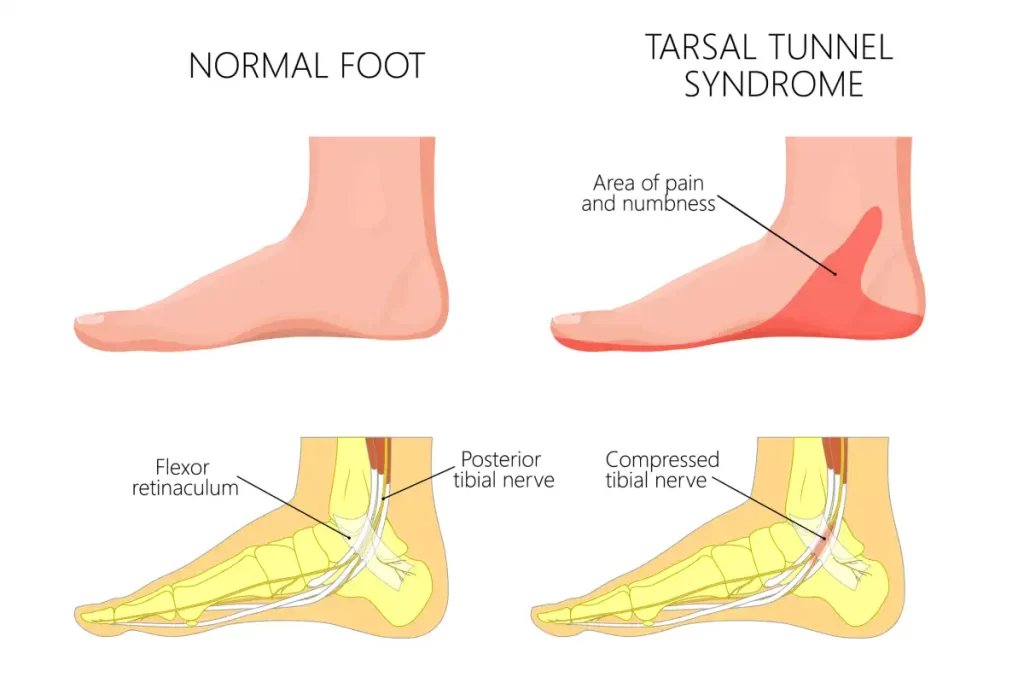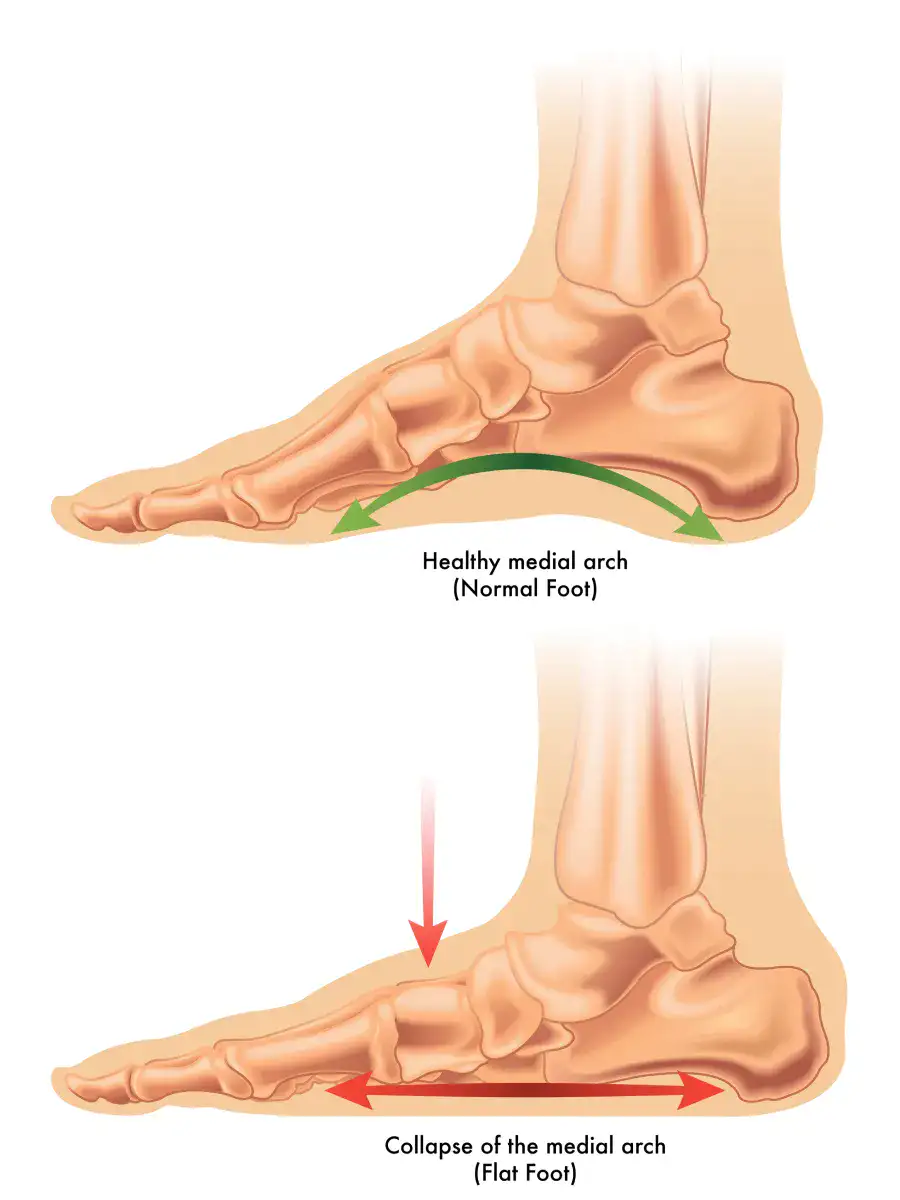Similar to carpal tunnel syndrome of the wrist but much less common, tarsal tunnel syndrome (TTS) is a nerve condition that affects the ankle and foot.
Formed by the ankle bones and the band of ligaments that run across the foot, the tarsal tunnel is a narrow space on the inner side of the ankle through which many tendons, nerves, and blood vessels that allow flexibility and movement travel. Tarsal tunnel syndrome occurs when the tibial nerve that runs through the tunnel becomes compressed or irritated. This compression can result from various factors such as injury, overuse, or systemic diseases like diabetes or arthritis that cause pressure on the nerve. Anatomical variations like flat feet or fallen arches, as well as a ganglion cyst, varicose vein, bone spur, or swollen tendon, can also contribute to TTS.
While there is no singular test for tarsal tunnel syndrome, podiatrists and nerve specialists use an array of physical and diagnostic tests to diagnose TTS.
How to Diagnose Tarsal Tunnel Syndrome
Tarsal tunnel syndrome is diagnosed through a combination of medical history evaluation, physical examination, and diagnostic tests. A thorough medical history helps identify risk factors and previous conditions that might contribute to nerve compression. During a physical examination, your foot and ankle or nerve specialist may check for tenderness, sensation changes, muscle strength, and reflexes in the affected area.
Tinel’s Sign & Related Tests
Your doctor might also perform Tinel’s sign test, tapping the area over the tarsal tunnel to elicit tingling or pain, indicating nerve irritation. The dorsiflexion-eversion test involves positioning the foot to compress the nerve, reproducing symptoms. Additionally, the plantarflexion and inversion test can exacerbate symptoms by increasing compartmental pressures.
Diagnostic Tests
Diagnostic tests for TTS include electrical testing – EMGs and nerve conduction studies – which measure how quickly electrical impulses move through the nerve, helping to identify nerve damage or compression. Imaging tests like MRIs, X-rays, and CT scans can visualize the tarsal tunnel area and surrounding structures, assisting in identifying abnormalities or sources of compression.
Tarsal Tunnel Syndrome Symptoms
Symptoms of tarsal tunnel syndrome include aching, burning, tingling, or shooting pain along the inner ankle and sole of the foot. Numbness or a sensation like an electric shock may also occur and you may notice a weakness in your foot muscles. Symptoms often worsen with prolonged standing or walking and physical activity. If you have chronic or severe TTS, you may experience these symptoms all the time.
Anterior Tarsal Tunnel Syndrome
Anterior tarsal tunnel syndrome affects the deep peroneal nerve on the top of the foot, leading to similar symptoms to tarsal tunnel syndrome, but in the dorsum (upper surface) of the foot where the extensor muscles are located. It’s less common than classic tarsal tunnel syndrome but presents with comparable pain, tingling, and burning sensations.
Tarsal Tunnel Syndrome Treatment

Many cases of TTS can be managed with conservative measures such as RICE (rest, ice, compression, and elevation) and anti-inflammatory medications to reduce swelling and alleviate symptoms. Other tarsal tunnel syndrome self-care options include orthotic devices or supportive footwear to help reduce pressure on the nerve.
If over-the-counter and at-home treatments don’t alleviate your TTS symptoms, your doctor may recommend steroid injections directly into the tarsal tunnel to reduce pain and inflammation or physical therapy that focuses on stretching and strengthening exercises. If all of these more conservative measures do not work, your specialist may recommend tarsal tunnel surgery to widen your tarsal tunnel or release your tibial nerve.
TTS FAQs
How long does tarsal tunnel syndrome last?
TTS recovery time varies based on the severity of the condition and the treatment methods. Mild cases might resolve within weeks to months with conservative treatments, while severe cases may take longer or require surgical intervention for relief. If your tarsal tunnel syndrome is caused by an underlying condition that can be treated, your TTS symptoms should go away after treatment.
Unfortunately, TTS caused by chronic conditions such as diabetes or arthritis may never fully go away and continued treatment may be required to avoid permanent damage to the tibital nerve.
What can be mistaken for tarsal tunnel syndrome?
Because tarsal tunnel syndrome is uncommon but often undiagnosed or misdiagnosed, seeing a specialist for proper diagnosis and treatment is imperative. Conditions like peripheral neuropathy, plantar fasciitis, stress fractures, or issues with the lower back or knee can exhibit similar symptoms, making an accurate diagnosis crucial for appropriate treatment.
If you’re experiencing signs and symptoms of the TTS, please contact us today for an appointment.

